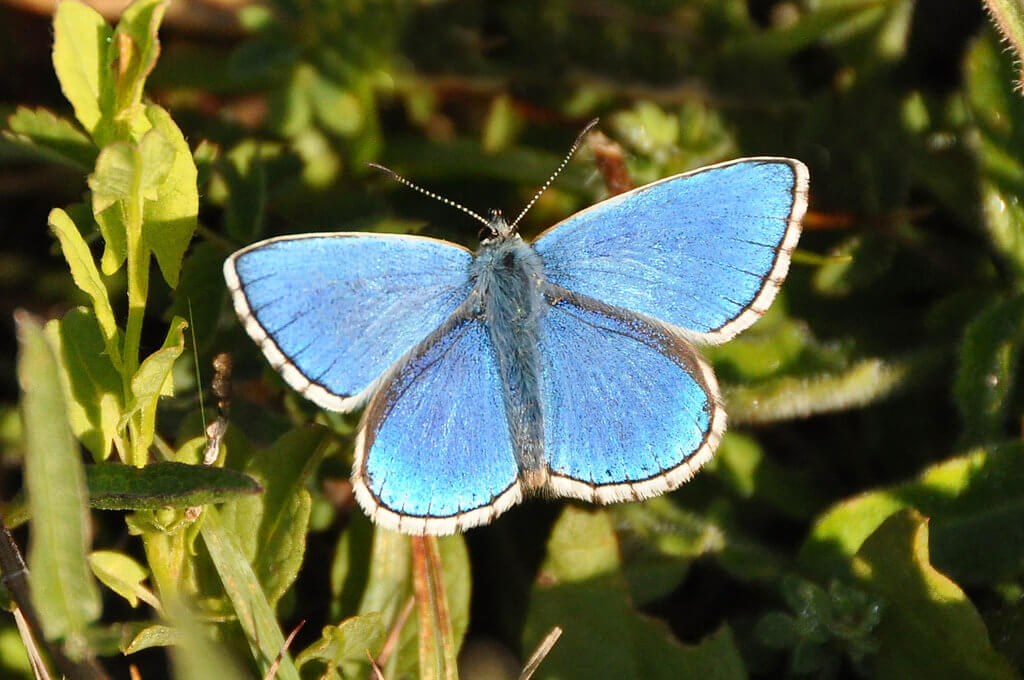
Hambledon Hill. Photo: John Miller.
Rising to the challenge – ancient hillforts and wildlife to be given new lease of life
Thirteen majestic iron age hillforts and 332 hectares (820 acres) of their surrounding landscape across Dorset and Wiltshire are to be given a new lease of life as part of a generous award of £800k made to the National Trust by Postcode Earth Trust, raised by players of People’s Postcode Lottery.
The £800k award will be used to fund two other National Trust conservation projects, along with continuing support for Heritage Open Days.
The £100k project will help protect all 13 Scheduled Monuments, dating from over 2,000 years ago, which are of national importance not just for their archaeology, but for their diverse fragile habitats which are homes to threatened butterfly species including the brilliantly coloured Adonis blue, the small Duke of Burgundy and the orange, yellow and brown chequered marsh fritillary.
The unusual sites include Hambledon Hill and Hod Hill in Dorset date from 5,500 to 2,000 years ago. At Hambledon an iron-age hillfort was built on the main hill. The defences can still be seen today and together with its three ramparts encircling the hill is one of the most impressive archaeological earthworks in southern England.
The work to be carried out ranges from erosion repairs to paths and ramparts to improving fencing so that cattle can graze in the summer and sheep during the winter. Volunteers will help with ragwort removal in the summer months, and there will be green hay spreading at some sites to enhance the diversity of wildflower populations.
National Trust ranger Clive Whitbourn says: “The hillforts protrude mysteriously from the landscape offering stunning views across the Dorset countryside. From Badbury Rings you can see the Isle of Wight, and from Eggardon Hill, Pilsdon Pen, Lambert’s Castle and Coney’s Castle there are views of Lyme Bay.
They are thousands of years old and reveal much about the way of life of our ancestors.
Due to scrub encroachment and erosion, urgent action is needed to protect them for the future for everyone.
The work we will be doing together with a small army of volunteers will include scrub removal, fencing and improving access to visitors. This will result in better care of chalk grassland habitat and help attract more wildlife. This will include wildflowers like pyramidal orchid and cowslip, birds like skylark and kestrel or mammals like brown hare – as well as butterflies – helping us meet our ambitions for nature.
Archaeological features including long barrows and round barrows will be better protected when the threat of root and scrub damage has been removed.”
Laura Chow, Head of Charities at People’s Postcode Lottery added: “We are thrilled that funding from players of People’s Postcode Lottery to the National Trust will continue to support the charity’s nature programme and Heritage Open Days in 2019.
Players’ support in 2019 will deliver significant conservation activity across England and Wales to improve a range of priority habitats, protecting our nation’s countryside for many generations to come.
The Wessex Habitats and Hillforts project will preserve not only part of our heritage but create the ideal habitat for attracting butterflies which we hope will then increase the number of rare butterflies.”
The remaining £700k awarded by Postcode Earth Trust and raised by players of People’s Postcode Lottery, will support the National Trust’s wider ambition to restore a healthy, beautiful more natural environment. Conservation projects include wildflower meadow and apple orchard restoration at the Brockhampton Estate in Herefordshire and the Trust’s national Riverlands programme, including on the River Bure in Norfolk.
ENDS

Adonis Blue. Photo: Tim Melling
[registration_form]
Let’s hope they get it right!! We had a situation locally where the county wildlife trust carried out management work for butterflies and orchids on one of its reserves , which involved grubbing out a large area of scrubland which was home to breeding nightingales and turtle doves, in spite of protests from the local ringing group. Not enough joined up thinking!!
Too right, Norman. I groaned when I read the bit about winter sheep grazing. On marsh fritillary sites this can be a ‘killer’, as sheep will not only selectively graze out devil’s bit scabious but will reduce the overall sward height to a level not suitable for this butterfly. And, yes, I know that the Adonis blue will possibly benefit but the general topography of hill forts already suits this species. The key to these problems is having well-informed staff making the decisions and not applying one size fits all vegetation management across whole sites.
And a shame to read that ragwort is still being demonised contrary to current thinking about the great value of this plant and despite the hyped up claims about its danger to livestock……
Isabella Tree in Wilding puts the case for ragwort very clearly.
I groaned when I read Ragwort pulling, unless the grassland is being turned into hay then this is completely unnecessary and is removing an important mid to late summer nectar source. I too worry about winter sheep grazing, I can remember this on two important Yorkshire sites for Dingy Skipper, by the time we got it stopped the colonies had been severely reduced. Personally I much prefer pony grazing.
Hmm as part of this exercise will they take action to a) not licence hunts to ride over and churn up the sites and b) take action against hunts which trespass as reportedly happened at Hambledon Hill?